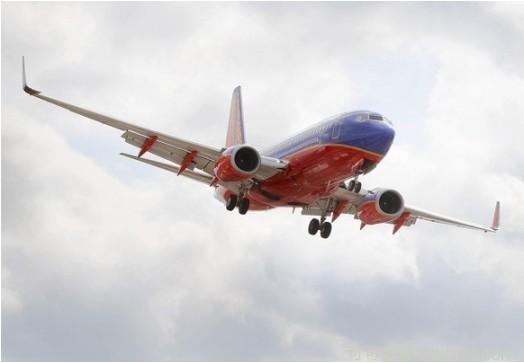
Science and Technolgy
科技
Metal fatigue in old aircraft
老舊飛機(jī)的金屬疲勞
Flying rivets
飛行偵查兵
A new technique that listens for cracks in ageing aircraft
一項(xiàng)偵聽老化飛機(jī)斷裂的新技術(shù)
WHEN they were built, no one thought they would fly for so long.
建造飛機(jī)的時(shí)候,沒人認(rèn)為它們會(huì)飛行這么久。
But fitted with new engines and avionics, aircraft can be kept going for a very long time.
但是裝有新式引擎和航空電子設(shè)備的飛機(jī)能持續(xù)飛行很長(zhǎng)一段時(shí)間。
The average age of the world's airliners is more than ten years, with some passenger jets 25 years old or more.
全世界飛機(jī)的平均機(jī)齡超過(guò)10年,有些客機(jī)的機(jī)齡超過(guò)了25年。
Military planes are more geriatric: the Sikorsky Black Hawk helicopter entered service 31 years ago and the Lockheed C-5 Galaxy 40 years back.
軍用飛機(jī)更是超齡:西科斯基公司的黑鷹直升機(jī)31年前開始服役,洛克希德公司的C-5銀河(運(yùn)輸機(jī))早用到40年了。
Both are still going strong.
這兩款飛機(jī)還都強(qiáng)勁地飛行著。
Some Boeing KC-135 aerial-refuelling planes, which are based on the venerable 707, have been flying for over 50 years.
波音707原型機(jī)上發(fā)展起來(lái)的波音KC-135空中加油機(jī)有些已經(jīng)飛行50多年了。
Engineers reckon they could still be in the air when they are 80.
工程師們測(cè)算80機(jī)齡時(shí)它們?nèi)匀荒茱w上藍(lán)天。
One thing that does ground old aircraft is the impending failure of their aluminium structure from metal fatigue.
讓老舊飛機(jī)擱淺的一件事就是飛機(jī)鋁構(gòu)造因?yàn)榻饘倨诋a(chǎn)生的故障隱患。
This begins in parts that are subjected to repeated strains, such as where the wings join the fuselage.
這種故障始于承受反復(fù)拉緊的部位,象機(jī)翼與機(jī)身的連接處。
Constant flexing of the structure concentrates stress, which leads to microscopic cracks.
這些構(gòu)造部位的頻繁伸縮使應(yīng)力集中,導(dǎo)致微裂紋的產(chǎn)生。
These cracks become more numerous and eventually large enough for the structure to fail.
這些微裂紋越來(lái)越多,最后多到足以使這些部位的構(gòu)造斷裂。
Aircraft engineers know a lot about how these cracks progress and keep an eye on them in routine overhauls.
飛機(jī)工程師們對(duì)這些裂紋如何發(fā)展以及在例行檢修中如何注意這些裂紋所知甚詳。
Nevertheless, they can be difficult and costly to find.
不過(guò)發(fā)現(xiàn)這些裂紋可能很難且費(fèi)用高昂。
Apart from careful visual inspection, techniques like X-rays and ultrasonic probes are also used.
除了仔細(xì)地目視檢查外,也使用象X射線和超聲探頭這樣的技術(shù)。
Now a British company has come up with a low-cost way of monitoring cracks in aircraft, even while they are airborne.
目前一家英國(guó)公司提出了一種成本低廉的監(jiān)測(cè)飛機(jī)裂紋方法,即使飛機(jī)在飛行中(也可進(jìn)行監(jiān)測(cè))。
The trick that Ultra Electronics uses is to listen for them with a system called Asis.
超級(jí)電子公司采用的訣竅是偵聽?zhēng)в凶詣?dòng)語(yǔ)音識(shí)別系統(tǒng)(Asis)的飛機(jī)。
It does this by fitting small piezoelectric acoustic sensors to parts of the structure to detect the particular frequency of noise caused by a crack in aircraft-grade aluminium.
把小型壓電聲傳感器安裝到這種構(gòu)造部位上,檢測(cè)由航空級(jí)鋁材裂紋所致的特定頻率的噪音,靠這樣就能監(jiān)測(cè)飛機(jī)裂紋。
When first set up, Asis is calibrated to the acoustic signature of the aircraft.
安裝之初,Asis就按飛機(jī)的聲波標(biāo)記圖進(jìn)行了校準(zhǔn)。
The system can point engineers to where cracks are occurring because the sensors also record the precise moment it is "heard".
這個(gè)系統(tǒng)能向工程師指明哪里正在出現(xiàn)裂紋,因?yàn)閭鞲衅饕灿涗浟鸭y噪音被"聽到"的精確時(shí)刻。
As the sound ripples through the structure it arrives at different sensors at different times, which can be used to work out the location and severity of the crack.
因?yàn)槁曇舫什ㄐ卧陲w機(jī)構(gòu)造中傳播,它在不同的時(shí)間到達(dá)不同的傳感器,這點(diǎn)能用來(lái)算出裂紋的位置和嚴(yán)重程度。
Once on the ground, a touch-screen device a bit like an iPad is plugged into the system and shows where any cracks are on a three-dimensional image of the aircraft.
一經(jīng)在地面上把有點(diǎn)象iPad的觸摸屏設(shè)備用插頭插入系統(tǒng)中,它就會(huì)在飛機(jī)的三維圖像上顯示所有裂紋。
Asis will be tried out later this year by America's Defence Advanced Research Projects Agency.
Asis將由美國(guó)國(guó)防高級(jí)研究計(jì)劃局在今年晚些時(shí)候進(jìn)行試驗(yàn)。
A basic set-up to monitor the boom on a small helicopter (a particularly stress-prone part) starts at around $65,000, says Rob McDonald, Ultra Electronics' marketing director.
超級(jí)電子公司的營(yíng)銷總監(jiān)羅伯?麥克唐納說(shuō),監(jiān)測(cè)小型直升機(jī)(特別是易受壓力的部位)嗡嗡聲的基本設(shè)備起價(jià)大約6.5萬(wàn)美元。
As to the future, he expects the company will explore how Asis might also monitor carbon-composite materials, which are being used increasingly in new aircraft.
至于未來(lái),他期待公司會(huì)探究怎么讓Asis也能監(jiān)測(cè)碳復(fù)合材料,碳復(fù)合材料在新式飛機(jī)中的應(yīng)用漸增。
Less is known about the long-term structural integrity of carbon fibre, but it is not prone to corrosion and is extremely tough, so with a bit of care and attention it might allow aircraft to fly even longer.
雖然對(duì)碳纖維的長(zhǎng)期結(jié)構(gòu)完整性所知甚少,但是它不易腐蝕且極為堅(jiān)硬,因此稍加關(guān)注它就可能讓飛機(jī)飛行得更久。



